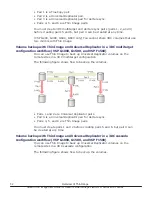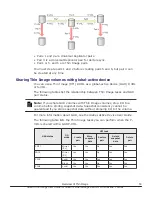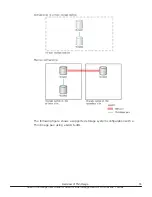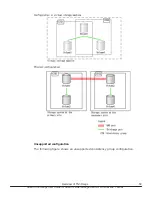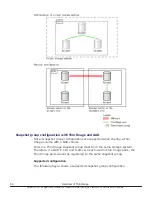
sure that the available capacity in the copy destination volume is greater
than the used capacity in the copy origination volume. For details, see the
Provisioning Guide for Open Systems.
• If you create a Thin Image pair using a volume with the capacity saving
function enabled, the compressed or deduplicated data is copied. Because
of this, copy or I/O performance may be degraded.
• When the capacity saving function is used, management information is
stored in a pool. As a result, there may be difference between a P-VOL and
an S-VOL in the number of used pages or licensed capacity.
• The capacity saving function can be set on the P-VOL or S-VOL of a
cascaded or clone pair, but only works on the clone pair. The deduplication
system data volume cannot be used as a Thin Image P-VOL or S-VOL.
• You can create a Thin Image pair whose P-VOL or S-VOL is a Dynamic
Provisioning V-VOL only if you are not currently expanding the Dynamic
Provisioning V-VOL capacity.
• Performing a Thin Image paircreate operation while zero pages are being
reclaimed (including reclamation by Writesame, Unmap command, or
rebalancing) results in the zero-page operation being interrupted.
• Thin Image pair creation might be rejected if the Unmap command
operation is in progress with system option mode 905 ON. Wait a while
and then retry the operation. If the operation still fails, set system option
mode 905 to OFF and try again.
• You can use a maximum size Dynamic Provisioning volume as a Thin
Image P-VOL or S-VOL. For information about the maximum size for
Dynamic Provisioning volumes, see the
Provisioning Guide
for your storage
system.
Related tasks
•
Creating V-VOLs for Thin Image S-VOLs
•
Creating Thin Image pairs using Device Manager - Storage Navigator
page 130
Sharing Thin Image volumes with Resource Partition Manager
You can create a Thin Image pair without regards to the resource group
assignment of the P-VOL and S-VOLs. You must assign the pool you are using
to the resource group where the P-VOL is assigned or to a resource group
where you can create Thin Image pairs.
For more information about resource groups, see the
Provisioning Guide
for
your storage system.
System option modes for Thin Image
To provide greater flexibility, the storage systems have additional operational
parameters called system option modes (SOMs) that allow you to tailor the
storage system to your unique operating requirements. The SOMs are set on
the service processor (SVP) by your service representative. Review the SOMs
Overview of Thin Image
63
Hitachi Thin Image User Guide for Hitachi Virtual Storage Platform G Series and F Series
Содержание VSP F1500
Страница 124: ...124 Configuring Thin Image Hitachi Thin Image User Guide for Hitachi Virtual Storage Platform G Series and F Series ...
Страница 202: ...202 Troubleshooting Thin Image Hitachi Thin Image User Guide for Hitachi Virtual Storage Platform G Series and F Series ...
Страница 203: ...Troubleshooting Thin Image 203 Hitachi Thin Image User Guide for Hitachi Virtual Storage Platform G Series and F Series ...
Страница 205: ...Troubleshooting Thin Image 205 Hitachi Thin Image User Guide for Hitachi Virtual Storage Platform G Series and F Series ...
Страница 320: ...320 Glossary Hitachi Thin Image User Guide for Hitachi Virtual Storage Platform G Series and F Series ...
Страница 324: ...324 Index Hitachi Thin Image User Guide for Hitachi Virtual Storage Platform G Series and F Series ...
Страница 325: ...Hitachi Thin Image User Guide for Hitachi Virtual Storage Platform G Series and F Series ...




